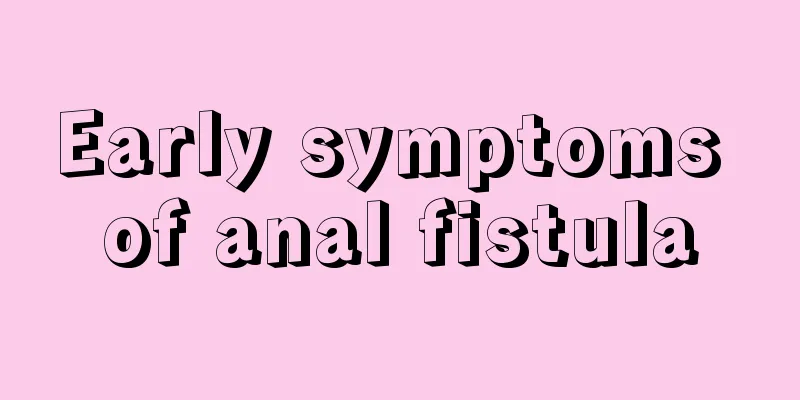Early symptoms of anal fistula

|
In daily life, anal fistula is a particularly common anorectal disease. In fact, most of the causes of anal fistula are caused by abscesses and ulcers around the anorectum. It is usually related to anal gland infection. Anal fistula disease has nothing to do with age. Anyone can get anal fistula. In fact, it is very important to treat anal fistula disease early. The following introduces the early symptoms of anal fistula. What are the early symptoms of anal fistula? Anal fistula is a very common anorectal disease. The main symptom is the repeated discharge of a small amount of pus from the external opening, which contaminates the underwear. Sometimes the pus irritates the skin around the anus and causes itching. The early symptoms of anal fistula are mainly abscess, pain and itching. 1. Pus The amount of pus varies depending on the length and size of the fistula. Newly formed anal fistulas secrete a lot of pus, which is thick, smelly, and yellow in color. The pus gradually decreases and sometimes disappears. The pus is white and thin in texture. If there is a sudden increase in pus, it means a new fistula has formed. Sometimes the external opening is temporarily closed, the pus flow stops, the body temperature rises, the local area swells, and an abscess forms again. The closed external opening is ruptured or a new external opening is formed, and pus flows out again. If the internal and external fistulas are large, feces and gas may sometimes flow out from the external opening. 2. Pain If the fistula drainage is unobstructed, there is generally no pain, only swelling and discomfort at the external opening, which worsens when walking. 3. Itching According to experts from Wuhan Boshi Anorectal Hospital, the skin around the anus is often irritated by secretions, feeling moist and itchy, and may become discolored and peel off. 4. Difficult defecation It is more common in horseshoe-shaped anal fistula, because the fistula surrounds the anal canal, forming a semi-circular fibrous ring, which affects the relaxation of the anus and may cause difficulty in defecation. 5. Systemic symptoms Generally, anal fistula often has no systemic symptoms, but complex anal fistula and tuberculous anal fistula have a long course of illness, some of which last for decades, and often cause symptoms such as weight loss, anemia, constipation and difficulty in defecation. If secondary infection occurs and abscess occurs again, symptoms of abscess will appear. Anal fistula surgery should strictly follow the treatment principles. During the operation, the principles and methods of sphincter treatment are as follows: 1. If the fistula passes through the subcutaneous part of the external sphincter, anal incontinence will not occur if the subcutaneous fibers of the external sphincter involved in the fistula are cut off or removed in the first stage. 2. If the fistula passes through the superficial part of the external sphincter or between the superficial and deep parts of the external sphincter, the superficial part of the external sphincter can be cut off in the vertical direction of the muscle fibers, but it cannot be cut obliquely, and the sphincter tissue around the fistula cannot be removed. 3. The sphincter can only be cut open, not removed in sections. 4. The sphincter can only be cut at one place, and never cut at two places at one time. If there are more than two fistulas at the same time or a complex anal fistula with two internal openings, surgery will have to be performed in stages, with either incision at one site and thread hanging at one site or thread hanging at two sites at the same time. 5. After the sphincter is incised, the gauze at the bottom of the wound should not be filled too much or too tightly to avoid the sphincter ends separating too far. 24 to 48 hours after surgery, the gauze packing should be removed to bring the sphincter ends closer together, which is beneficial for early healing and functional recovery. 6. If the fistula passes through the anorectal ring or internal opening, is above the ring, or has an unclear anatomical relationship with the anorectal ring, a secondary resection should be performed, i.e., the superficial and subcutaneous part of the external anal sphincter is cut, the fistula below it is incised or removed, and a rubber thread is then inserted from the remaining fistula opening, led out through the internal opening, and tied tightly to the anorectal ring. The cutting effect of the rubber band is used to slowly open the fistula wall and the tissue below it, causing strangulation, ischemia and necrosis. |
<<: Does anal fistula require immediate surgery?
>>: Is the chance of false healing of anal fistula high?
Recommend
What should I do if my tongue coating is black?
The tongue coating is the white, fetal-like subst...
What fruits are good for liver cancer patients? Eating these 6 kinds of fruits regularly is good for liver cancer
Liver cancer is a malignant disease that occurs i...
Introduction to the causes of esophageal cancer that everyone should know
In recent years, with the change of eating habits...
What to do if toenails grow into the flesh
Compared to fingernails, toenails are actually mo...
How long does it take to drive after drinking 6 bottles of beer? Don't drive after drinking
Now the country's penalties for drunk driving...
Can loofah really remove spots?
Every woman hopes to have skin as silky and trans...
How to remove glue stains
In daily life, people inevitably have to use vario...
What changes will happen to your body if you shave your armpit hair
Many girls choose to shave their armpits because ...
What should I do if my throat is inflamed
In addition to taking some medicines, it is actua...
How can people with a peaceful constitution take care of themselves to prevent lymphoma
To prevent lymphoma, you must first determine you...
Is it okay to take medicine without surgery for pituitary tumor?
Modern people live at a fast pace and face great ...
Is chemotherapy useful for advanced liver cancer?
Is chemotherapy useful for advanced liver cancer?...
What sleeping position at night can help you grow taller
Some parents attach great importance to their chi...
Will cystitis turn into bladder cancer? Explore the root cause of bladder cancer
Bladder cancer is not unfamiliar to everyone. I b...
Introduction to TCM methods for treating kidney stones
There are surgical treatments and drug treatments...









